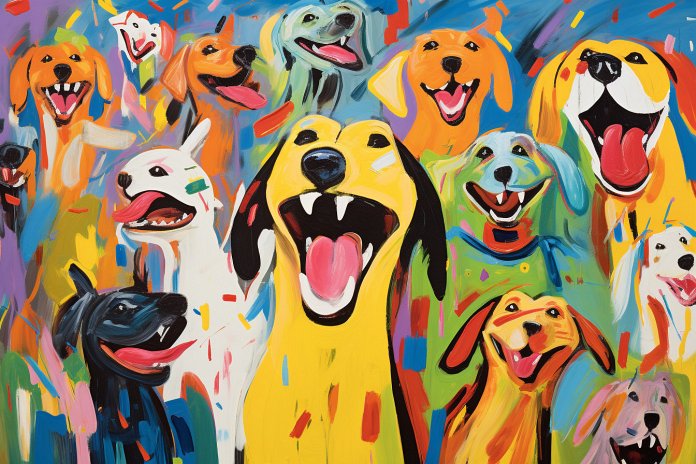
We’ve all been there. That moment when you look at your pup staring back at you with gleaming eyes, a wet, pink tongue sticking out, and what looks like a super-sappy smile. You think to yourself, “Aw my pup must be so happy!” But is your dog really smiling the way us humans do? Is this pure dog-bliss?
We’re going to delve into the science behind smiling pooches, along with signs that often lead people to believe their pups are grinning.
Signs You May Think Your Dog is Smiling
It is quite possible to gauge your dog’s body language to determine how your dog feels. Dogs that are genuinely happy tend to exhibit a general looseness to their bodies.
If the sides of your dog’s mouth point upwards, that often, but not always, signifies that all is well. You can learn even more from your pup’s tongue. A tongue that hangs loosely combined with a mouth hanging open can point to a good, happy mood.
Although dogs don’t actually smile like humans, they sometimes happen to make expressions that look like smiles. You may see some behaviors in your dog that lead you to believe your pup is smiling. If your pup has all their teeth bared, that’s usually a warning sign telling you to back off. However, you may also see forms of “smiling” after giving your pup treats or petting.
Body Language
Here are some signs you may interpret as “smiling”:
– Head Tilting
– Wag Tail
– Lip Licking
– Tongue Hanging
– Exposed Teeth
Other Signs
Other “smiling” signs include:
– Being Extra Playful
– Lips Curved Upwards At The Ends
– Relaxed
– Bared Teeth
The History Behind Doggie Smiles
In wolves and other canines, a “smile” indicates nervousness or even signals the acceptance of subordination. As descendants of wolves, dogs also are also internalized to interpret smiles this way.
The Science Behind Doggie Smiles
In a 2012 study, neuroscientists examined both humans and animals, discovering that animals too have consciousness and emotions. When dogs feel content, they tend to exhibit loose or relaxed body language. This can include facial muscles tending to be relaxed, a mouth that may hang open (or a tongue hanging out), and the corners of the mouth turned upwards. Although experts say dogs can have emotions, they can be hard to read or understand.
Researchers have ultimately concluded that dogs don’t actually smile the way humans do. What we see is the result of submissive behavior and automatic responses, rather than an enjoyment of happiness.
Additionally, a dog’s smile may indicate another feeling, like anxiety or nervousness. If your dog is “smiling” while also panting heavily, whining and chattering their teeth, you may want to consult your veterinarian.
Training Your Dog to Smile
Although your pup may not experience happiness the same way humans do, it is possible to train your dog to “smile.”
You can do this by rewarding your pup for “smiling” in the form of treats, belly rubs, or even just general excitement and “good boys.” The positive reinforcement will teach your dog that every time they perform a “smile,” a reward is coming.
Also, some studies have revealed that our dogs do mimic our facial expressions to some extent. If you have a clever pupper that tends to copy you, why not try to put in some smile time? Make sure there are no distractions, have your dog sit, and give them some over-exaggerated grins while saying “smile” right after.
If they begin to make a similar expression, immediately reward them with a small treat and praise. Repeat the sessions regularly, but keep them fun and short to be the most effective – and always end on a high note!
Dogs may not actually smile like humans, but they can exhibit behaviors that resemble smiling.

Tips & Things to Know
1️⃣ Dogs don’t actually smile like humans do, but they can make expressions that look like smiles. Look for signs such as an upward-pointing mouth, a loose tongue, and a generally relaxed body to determine if your dog is in a happy mood.
2️⃣ Pay attention to your dog’s body language to interpret their “smiling” behavior. Signs like head tilting, wagging tail, lip licking, tongue hanging, and exposed teeth can be indicators of a happy dog. However, be cautious if your dog has their teeth bared, as it can be a warning sign.
3️⃣ While dogs may not experience happiness in the same way humans do, you can train them to “smile” using positive reinforcement. Reward your dog with treats, belly rubs, or excitement when they perform a “smile” behavior. Additionally, some studies suggest that dogs mimic human facial expressions, so you can try to encourage a smile by demonstrating it yourself and rewarding your dog when they mimic the expression.
Frequently Asked Questions, Answered ✅
1. Can dogs really smile like humans?
– No, dogs don’t actually smile like humans, but they can make expressions that resemble smiles.
2. How can you tell if your dog is happy?
– A loose and relaxed body language, a tongue hanging out, and corners of the mouth turned upwards can indicate that a dog is happy.
3. What are some signs that may be interpreted as “smiling” in dogs?
– Head tilting, wagging tail, lip licking, tongue hanging, and exposed teeth can be signs that a dog is “smiling.”
4. What is the history behind doggie smiles?
– In wolves and other canines, a “smile” indicates nervousness or signals acceptance of subordination. Dogs, as descendants of wolves, interpret smiles in a similar way.
5. Can dogs be trained to smile?
– While dogs don’t experience happiness the same way humans do, it is possible to train them to “smile” using positive reinforcement. Rewarding them for performing a smile can teach them to associate it with a reward.